
|
 |

|
 |
RAMAA BHARADVAJ - Lalitha Venkat, Chennai e-mail: lalvenkat@yahoo.com Jul 2002 Trained in Bharatanatyam and Kuchipudi, Ramaa Bharadvaj, the Director of Angahara Ensemble in California, is a dancer, teacher, choreographer and actress with over 3 decades of creative achievements. Her performances have been listed by Orange County Register, as one of the Most Memorable World Dance events of 1992, 1997 and 2000. 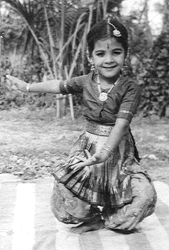
Ramaa (3 years old) A tireless advocate of multicultural education, she has taught at various universities and colleges and has reached thousands of inner city children through her outreach presentations. She is the recipient of numerous grants from the California Arts Council and is currently on the dance faculty at Orange Coast College in Costa Mesa, CA. On Sunday April 7th, 2002, Ramaa Bharadvaj became the recipient of the prestigious Lester Horton Dance Awards at a glittery ceremony held at the Japan America Theater in Los Angeles. She has set up an endowment in Chennai for the Venkatakrishnan Memorial Award, which will be administered by the Sruti Foundation. Ramaa has firm viewpoints on various issues and when she was in Chennai this June, it was an ideal opportunity to let her talk on a variety of issues relevant to Indian dance in America. 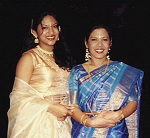
Ramaa and Swetha Bharadvaj How did you feel when you received not one, but two Lester Horton awards this year? I won my first Lester Horton back in 1993. It took nine years for me to get up on that stage again, but winning 2 awards on one night made up for the wait. The wonderful thing about this award is that the selection is not done by a bunch of judges, but by your colleagues in the dance community. At the ceremony, the first award they announced was for Outstanding Achievement in Performance. The thrill of winning that took almost half an hour to subside. I was literally shaking, my knees were buckling under me. I have a video, you have to see it (I did see it along with her acceptance speech!). After intermission, they announced the second award, which was for Outstanding Achievement in Choreography. This was completely unexpected. I was thrilled that being listed with the more popular modern dance category, Indian dance won. The first one made me very happy and proud, but the second one was a very humbling experience. With every award there also comes a tremendous responsibility. You have the opportunity to become a role model for your community and you have to strive to be the best you can be. It is also an empowering feeling, for with every recognition, there opens up a venue, a platform to express your viewpoints, to be seen and heard. It demands alertness and focus. 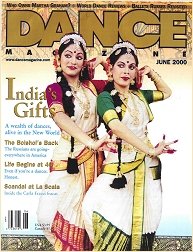
Ramaa and her daughter Swetha on the cover of Dance Magazine You and your daughter were featured on the cover of Dance Magazine. That must have been a great experience too. The Dance Magazine, as you know, is one of the most noted dance publications in the world with over 300,000 readers globally and critics and correspondents in at least 22 countries. My daughter Swetha and I were being interviewed for an in-depth article about how the second generation artists growing up in the United States were coping with their cross cultural identities and how they are carrying on the tradition. The editor asked us for several photographs to look at. So, I just sent a bunch, all taken by my husband and didn't think much of it. When the magazine came out, the writer Laura Bleiberg called and said, "Ramaa, I hope you are you sitting down, because you and Swetha just made the cover of Dance Magazine June 2000." I was in shock for quite a long time. There was also an article on Bolshoi Ballet in the issue and Kuchipudi beat Bolshoi ballet to the cover! Our photo on the cover actually brought international attention to us and to the dance form that we represent. It was one more opportunity to promote the art form I do, more rewarding than people just saying, "Ramaa made it to the cover." 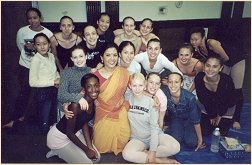
Ramaa with her students from Ballet San Jose School You serve on some of the art panels in California. Can you tell us what being a panel member entails and how you go about making your decisions? We have both state and national level arts agencies that get funding from the state government or the central government, and they diversify these funds in the form of grants for artists. California's arts agency is called the California Arts Council. It was in 1993, that I got invited to serve on one of their panels. Obviously I did something right, because they have called me back again and again. So far I have served on 6 different panels for California Arts Council, 1 for the National Endowment for the Arts and 1 for the Los Angeles Cultural Affairs Department. Serving on panels is done on a voluntary basis and it is grueling work. We begin our work 4 to 6 weeks prior to our meeting. We have to study, and make intensive notes on 90 or 100 applications. The actual panel can last up to 4 days. We work almost 10 hours each day reviewing proposals, budgets and art samples submitted by the applicants. Based on our recommendations, the government decides how the money should be distributed among the artists. I take this assignment very, very seriously. My job is not just to rank applicants but to educate the other panelists and the CAC staff about the cultural influences that make us practice our art the way we do - not just the Indian dancers but any World Dance form for that matter. A person familiar with only ballet or modern dance looking at all dance forms from the Western perspective sometimes cannot understand that. Sometimes I may be the only dance practitioner who is sitting there. I have even gotten up on the table and danced for the other panelists, whatever it takes to make my point. One thing I insist is that I am not going to base my ranking on how well your grant is written but on how good your work is. If the work is shoddy no amount of fancy mumbo jumbo on paper is going to get my support. It's all about awarding excellence in arts and that's the only thing that should matter. Unfortunately with the proposed budget cuts in California we don't even know if the California Arts Council is going to survive. What measures are you taking to combat this fight for survival? I am getting politically involved. I had a meeting with Michael Alexander who is a prominent presenter in Los Angeles and an important member of California Arts Advocates. He feels that there are not enough artists who would take time off from their creative work to get politically involved. He was excited that I showed interest in that aspect and feels that I have what it takes for that job. I believe that as artists we have to go beyond just presenting ourselves and our work. That's kind of narcissistic. We have to represent our art both creatively and politically. I am actually proposing an 'Artists for Art' campaign. The Dance Resource Center and several other organizations have offered me their support. We are dancers, choreographers, directors, musicians -- we are creative people who choreograph and script drama and excitement on stage everyday. If we cannot use our talents to create the most dramatic campaign to send a message to the politicians, we might as well find a different profession for ourselves to practice. 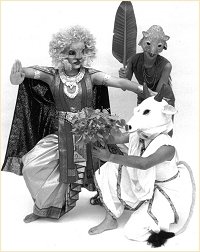
Ramaa as the Lion King in her production Panchatantra How do you view Indian contemporary dance that is staged in the US? There is nothing wrong in contemporarizing Indian dance. Tradition itself is a contemporary thing and for a tradition to continue new energy must constantly offer the nourishment of new experience. Like a river it has to flow incorporating everything in its way into itself, changing, adapting and evolving! What we have to be concerned about is the modernization of Indian dance by stripping it, diluting it or demolishing the technique. There is a difference. However, I have to hasten to add that I also strongly believe in the artists' basic freedom to create. Recently at a conference at Chicago, I was saddened by the uproar that was created after a performance by Chandralekha's presentation of Sharira - an exploration of the erotic power of the human body. It was okay to watch stories of Krishna's adulterous relationships enacted through gestures in a classical dance presentation, but it was not okay to watch this because it made the traditionalists too uncomfortable. I was on the review panel and spoke up for Chandralekha's presentation because I believe in the artist's basic freedom to create. No one has the right to deny or take away that freedom. Otherwise there is a danger of us repeating the horrors of the Khmer Rouge and Cambodia. It is censorship and I am against it. To take the controversies further, do you think the traditionalists raise a hue and cry about artists who are willing to step out of the boundary and do something different? Do they do that because they feel they cannot try new things at that stage in their lives, that they are great gurus, legends in the traditional scheme of things? Or is it the purist in them, saying this is what we learnt, what we practice, what we taught, and that's the end of that? I cannot put myself in the mental frame of others and answer for them. But I will say this, that first of all, what is classic will remain classic, commanding admiration and respect for generations. It will never go out of style. The rest will come and go as a fad, like bell bottoms and mini skirts. There is no need to be threatened by the fads. The best way to make a statement is to simply continue to do our work with more conviction and perfection. There is enough vigilantism & fanaticism in the world. Why bring it into the art field? Secondly, if you want to look at it philosophically, it all boils down to the basic problem of categorizing Right and Wrong based on our own belief systems. But you see there is no absolute right or wrong in anything. A thing is wrong for you when it does not express your true thoughts and ideas and does not speak about who you really are. About 10 years ago, I was offered Rs.5 lakhs by an industrialist in India who wanted me to choreograph a production based on a specific theme. I politely turned him down because the theme didn't inspire me. It is a debilitating feeling to try to create art that feels wrong for you. And every artist must have the right to take the risk to create what feels right for themselves from within their own inner self with absolutely no fear or pressure whatsoever. My favorite prayer verse is from Tiruvacakam, a holy book of the Tamil Saivite literature. In it Manickavacagar says to Siva, "Whatever You desire for me is what I desire for myself, and if I desire something, that too must be Your desire." So if we believe that when an artist has the desire and urge to create, that basic inspiration itself is Divine, then there is no question of saying that the inspiration of the purists and traditionalists is Divine and every body else's is satanic. It is ungracious to try to cripple the creative urge in another artist through intimidation. It is like snuffing their life spark. As long as the artists who wish to experiment do not label their work as traditional Bharatanatyam or Kuchipudi, they are entitled to their experimentation. And those raising a hue and cry about it are probably speaking from their egos and not their hearts. 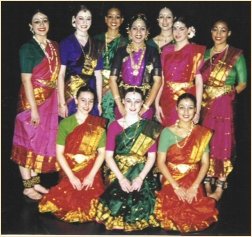
Ramaa with American students from the Los Angeles County High School for the arts You said you aim to bring Indian dance into the mainstream. How do you propose to do that? I have already been doing it through successful collaborations, participation in major festivals and performing venues, outreach presentations and workshops in major universities and colleges in Southern California. I have even appeared on radio shows to talk about Indian dance. I also give a lot of my time to the dance community in an advisory capacity. Making your presence felt in the community is as important as spending time in your studio. I write on dance, speak at events, attend conferences, and also offer my help to any dance community member who needs it. I am not interested in working towards just finding performance opportunities for myself. What drives me is a desire to create a wider audience, a wider family that can provide a nurturing environment for Indian dance. I work towards it with genuine passion. I look at it as creating a family around myself, sharing my knowledge and contacts and connecting people with one another. Then people look up to you as a link, a conduit that brings the community together, as someone they can trust and turn to. That's how you grow and succeed. Otherwise you are just a leech and nobody likes leeches. Are you trying to make Indian dance more visible or more accessible? Both. There are the elite American audiences who are totally familiar with India. Then there are others who have studied yoga and of course they know of Ravi Shankar and the Sitar. The third category is the crowd that does not know the difference between Asian Indians and American Indians. All audiences are important to me. I do not dance for the elite alone. In fact it is a rewarding feeling to open the eyes and touch the hearts of those who have no idea what Indian dance is all about. The challenge is to make our art form both physically and aesthetically accessible to them. If you can do that, then visibility automatically follows. 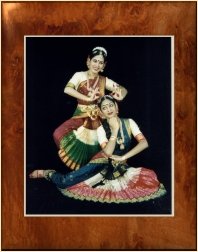
Ramaa and Swetha Bharadvaj How successful have you been in that regard? Well, in the last 7 years, we have not had to self-present a single performance. It has all been invited performances. That should speak for our success rate. I have taken my dance to new venues creating new audiences. Our 2001 performance at the Norton Simon Museum is an example. They have a beautiful theater. But they have used it only for lectures and films. This was the first time that they have ever presented dance in their 25-year history. I designed a 45-minute program for them based on the Chola bronzes in their collection, to emphasize the idea that performing art and visual art cannot be separated. In spite of the low budget at my disposal, I booked my own lighting designer at my expense to enhance the presentation. It was a sold-out performance. Mrs. Simon, herself, who I hear is a recluse, came to the event and has expressed interest in more such events. At a time when dancers are struggling for venues to present themselves, I feel I have probably opened up one for future dance performances. In that aspect I feel the success of my performance is important. I have been successful in my capacity as a teacher as well. The Los Angeles County High School for the Arts has invited me twice to teach for an entire semester. These students come from poor neighborhoods. They would have no access to Indian dance or interest in it. I was able to give them that experience and both times, I presented them in a performance that had the audience gasping in wonder. My husband I even made costumes for them at home. For the past 2 years I have been working with ballet students at Ballet San Jose school, training them in Bharatanatyam, and teaching them to explore their bodies differently. The artistic director, Dennis Nahat was so impressed that he has invited me to go to New York with him to work for 8 weeks in a dance camp teaching children from the poor neighborhoods of the Bronx. I treasure these opportunities. 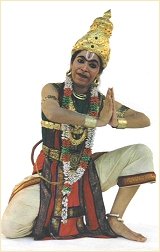
Ramaa as Hanuman in her collaboration with Asian Story Theater's production of Hanuman and the Monkey King What factors contribute to failure in achieving this goal? One is lack of on-stage professionalism. We cannot start performances late, or dance endlessly for 3 hours. Also standing on stage exchanging plaques and bouquets and thanking every relative, alive or dead - these things plague the Indian dance performances turning them into community gatherings rather than professional performances. What should belong at a private party or eulogy at a memorial service is all brought on stage and the audience are made to suffer through this torture. Also, don't let your husband and your brother-in-law come and operate lighting for you. Get a professional lighting designer. That's what they are for. The other thing is choreographic lethargy. We have to get out of it. We have to constantly reinvent our dances. By this, I don't mean new choreographies for every show, but readapting the repertoire to suit the venue and the audience. Many dancers create a piece for a proscenium stage and you see the Xerox copy of it everywhere. Such presentations flop miserably. You have to revitalize the dances and make it look like as if they are site-specific works specially created for that particular audience and that particular dancing space. In the summer of 2000, we were invited to perform at Grand Performances one of Los Angeles' most prominent performing venues. It is a gorgeous open-air stage, surrounded by pools of water. I looked at the venue and decided to present my choreographies on water-based themes. I completely restructured and re-choreographed my 'Ganga Tarangam' using the stairs, ramps and waterfalls at the venue as part of my presentation. My dancers even floated lamps on the pool of water to create a visual effect of being on the banks of the Ganga. We got a standing ovation from an audience of 2000. I have been invited back again this year. I am creating a special show called "Yatra -A Journey to India" which will be presented on August 18th, 2002. You are saying that by constantly readapting, reinventing or reinterpreting the traditional form of a certain style, to reach a larger audience is by no means backtracking or demolishing a traditional form, but to do it in a way without eroding the basic tenets of that style. Absolutely. Authenticity is important. Western audiences who come to see Indian dance want to see the real thing. They want the entire experience of costumes, music, movement and magic. So there is no need to underestimate the intelligence of the audience. There is so much material to draw from in our own tradition. They just need to be reinterpreted with a contemporary flair. For example, the story of Krishna lifting the Govardhana Mountain itself offers a significant environmental concept when Krishna says, "Why do you have to worship Indra? Worship the trees, the mountains, the cows". But we have to also remember that history has progressed from the times of the Ramayana and Mahabharata creating new stories, stories as powerful as the mythological ones, complete with the miracles of man's strength. We have to make room for their portrayal as well. We cannot throw the Sastras and Puranas in someone's face or keep saying, "You cannot do this because it is not in the Natya Sastra". At the Chicago conference, Hema Rajagopalan showed us how she used the katakamukha gesture to depict a giraffe, I showed them my gesture for an owl and Sonal Mansingh showed her gesture for a cockroach! It was fascinating. How can we narrate the story of India's freedom struggle or that of Mahatma Gandhi or Martin Luther King for example without inventing a gesture for a gun? Such reinvention within the framework is necessary. 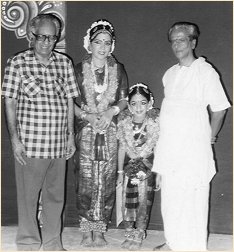
Ramaa and 6 year old Swetha with Sankarabaranam Venkatakrishnan during a 1987 performance What prompted you to institute the Venkatakrishnan Memorial Award? Sankarabaranam Venkatakrishnan was an extraordinary human being. Everything he did stemmed from a deep and genuine caring that he felt for the community of Indian dancers, not just at a regional or national level, but a global level. He was especially a champion of the young and delighted in discovering their talents. I watched him even play the role of an office assistant as he addressed over 800 invitations by hand and carried them in bundles to drop them off in the nearest post box. At a time when other organizers would throw their hands up in the air, shrug their shoulders and murmur that classical dance did not, would not, and could not attract a sizable audience in the city, maama not only got an audience for his dancers, he generated tremendous media interest for them as well. He had no immediate family, for he never married. We were his family - the dancers that he nourished and the dance community that he cherished. When Maama passed away four years ago there were a few obituaries here and there, but the community that had benefited from him didn't remember him in a very honorable way in which he deserved to be remembered. I felt compelled to do something in his memory. It was important not just to keep his name alive, but to keep alive the vision, the wisdom and all the benevolent principles for which he stood, for it is from the wisdom of the elders such as Maama that we learn our lessons for the future. My desire to create an award in his name was brought to fruition by Mr. Pattabhiraman who encouraged me and graciously agreed to administer this award through the SRUTI Foundation. The award will be given once in 2 years to a promoter of dance who specifically encourages classical dance, and young dancers. Mr.Yagnaraman gets the first award this year. It's special because he turns 81 and for several years, through his Natya Kala Conference, he has actually turned Madras into a tourist spot that attracts people not only from India, but from abroad as well. We hope to identify more such presenters for dance. There are presenters galore. But where is the audience? Is it not becoming increasingly difficult to take up dance as a career? That's because dance is looked at as a hobby or a means of cultural education, and not as a profession. Practicing dance as a mere hobby leads to mediocrity. If classical dance has to become a legitimate career, we have to approach it as such, with at least a 30% business sense. It is so important to constantly work at developing an audience or we will have no one to dance to. Creating dance for an audience that is not there is like selling iceberg in Alaska. Who is going to buy it? Part of that development process depends on how you present your art. Lewis Segal, the dance critic of the Los Angeles Times had a wise advice actually. He said, "I'm not interested in how you danced in your previous incarnations. When you come to this country, you are dancing here for this audience. You have to make every effort to make them appreciate it, to make them understand it. If you lose them, you have failed." Even Indians are prepared to pay $100 tickets to go watch an Indian film personality gyrating in his westernized outfit but won't pay $20 for a Bharatanatyam concert. Dance appreciation workshops can help, but it is even more important to make our performances interesting and entertaining. That's the key word here. Make it entertaining for them and they will come. After all, isn't that why people go to the theater, to be entertained? What is it about the Indian dance scene that disturbs you? I am disturbed and irritated by that categorization "NRI dancer." It offends me tremendously. As my friend Nala Najan once told me, "What is that term NRI all about, Name, Rank and Information? It's the most racist title. We are artists and that is the only identity we need." I couldn't agree with him more, and yet I keep hearing that annoying term over and over again in India, murmured in loud whispers over my head as if I am an untouchable with a dangerous communicable disease. A prominent dance scholar once told me, "For events like Khajuraho Festival, we do not choose NRI dancers." That's a stinky statement if I ever heard one! At a time when the world is getting smaller and closer through communication, travel and conferencing activities, why is it that you have to brand people by a name that does not exist within the realm of dance? Why do you separate us geographically and politically? There are only two categories that should describe a dancer - good dancer and bad dancer - and nothing beyond that. If anyone calls me an NRI dancer, I answer back, "I have only had training in Bharatanatyam and Kuchipudi. Unfortunately I never studied that NRI dancing". I met Leela Venkatraman for the 3 day Houston conference and had no idea that when she returned to India, she wrote a 2-page article in The Hindu about my activities in the US. Leelaji looked at me simply as an Indian dancer who's practicing her craft in a different geographical location. It really touches me when I see critics do this for us. It's the same with this Narthaki Online interview for instance!! It's thrilling for me, to be recognized simply as a dancer who is doing her job well. That term "NRI dancers" is the most politically incorrect term in the dance vocabulary. It has to go. We have to unite as a dance community and as a family. Do Indian dancers in the US watch only Indian dance or other dance forms too? Personally I always attend all kinds of performances to watch dancers from Brazil, Africa, modern dancers, ballet dancers...I have not seen many Indian faces in all these audiences. It really irks me. Especially if you are a dancer, you have to familiarize yourself with what your colleagues are doing. What is the point in living in a culture where you have access to the world and then shut your door and go and see the same fish and same frog in your backyard pond? Sometimes I hear the statement "oh, that is not relevant to us." So what? As long as you are living in this world, everything that happens in it is relevant to you. The dance world is especially such a small world. We all have to make it relevant to us or we will be dancing in a vacuum. 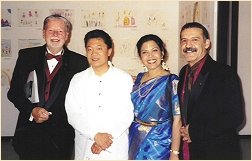
The AVATAR dance directors - L to R Dr. Tony Shay, Joel Jacinto, Ramaa Bharadvaj and Jamal What's your latest avatar?? Strange you should ask that because that's exactly the name of my new Dance Company - AVATAR! As you know, I have my own dance company, the Angahara Ensemble for Indian based dances. This new company is a marriage of 4 highly successful dance companies in the Western United States representing 4 powerful dance traditions of the world - Iran, India, Philippines, and Bali. We aim to create a true collaboration in music, content and choreography. Our performances will have the grandeur and technical mastery of our particular dance styles, which will match high international standards. However, although our theme will come from our traditions we are interested in contemporariness, and by that I mean making it relevant to the community we live in by adapting it to depict our immigrant lifestyle. Our rehearsals start in August and I am looking forward to it. What is the wisest advice you have heard till now for Indian dancers? Unquestionably from Nala Najan who said to me, "Don't let anyone quote the Natya Sastra to you or tell you how you should dance or what you should dance about. It is you the dancer who creates the dance. The Gods might have inspired it, but you are the living tradition. Without the human body there would be no dance, no Sastra. You are the Natya Sastra. You are Siva. Remember that always." I will treasure this advice always. Ramaa Bharadvaj Director - Angahara Ensemble 5535 Via Verano, Yorba Linda, CA 92887-4931 Ph / Fax: 714 - 692-1695 e-mail: angahara-ramaa@yahoo.com ramaadance.org |